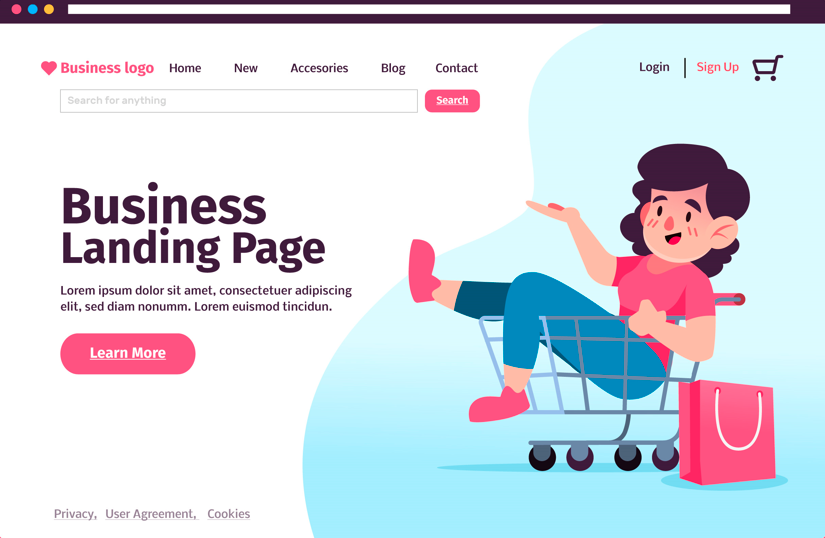Website vs Landing Page
In the digital realm, businesses often find themselves torn between the two powerhouses of online marketing – websites and landing pages. Both are crucial elements in the conversion battle, and choosing the right one can significantly impact the success of your marketing efforts. In this article, we will delve into the differences, strengths, and weaknesses of the topic website vs landing page, helping you make an informed decision for your business.
Understanding Websites

1.1 What is a Website?
A website is a collection of interconnected web pages accessible via the internet. It serves as the online representation of a business, providing information about products, services, and company details.
1.2 The Function of a Website
Websites act as the central hub for businesses online. They provide a platform to showcase offerings, interact with customers, and establish credibility.
1.3 Benefits of Having a Website
Having a website allows businesses to have a permanent online presence, expanding their reach globally. It enables them to provide detailed information and offers an opportunity to incorporate various content formats.
1.4 Limitations of Websites
Websites might overwhelm visitors with information, making it harder to lead them to specific actions. They can also be challenging to optimize for conversion due to their multifaceted nature.
Understanding Landing Pages

2.1 What is a Landing Page?
A landing page is a standalone web page designed with a single, clear purpose – conversion. It focuses on driving visitors to take a specific action, such as signing up for a newsletter or making a purchase.
2.2 The Purpose of a Landing Page
Landing pages aim to convert visitors into leads or customers by presenting a compelling offer and eliminating distractions.
2.3 Benefits of Using Landing Pages
Landing pages have a focused approach, making them highly effective for targeted marketing campaigns. They simplify decision-making for the visitor, streamlining the conversion process.
2.4 Limitations of Landing Pages
While landing pages excel at conversion, they might not provide enough information to build long-term relationships with customers. Moreover, maintaining numerous landing pages for different campaigns can be time-consuming.
Website vs. Landing Page
3.1 Key Differences
Websites are comprehensive and versatile, while landing pages are single-focused and action-oriented. Websites cater to a broader audience, while landing pages are meant for targeted marketing.
3.2 Conversion Rate Comparison
Landing pages often boast higher conversion rates due to their focused design. However, websites can reach a wider audience and contribute to long-term customer engagement.
3.3 When to Use a Website
Use a website when you need to provide detailed information about your business, offerings, and establish an online presence. Websites are ideal for brand building and long-term relationship nurturing.
3.4 When to Use a Landing Page
Utilize landing pages for specific marketing campaigns, product launches, or time-sensitive offers. They are effective when you want to direct the visitor’s attention towards one specific action.
The Conversion Battle
4.1 Understanding Conversion
When a visitor completes the targeted activity, such as completing a purchase or signing up for a service, conversion occurs. Both websites and landing pages play a crucial role in optimizing conversion rates.
4.2 Optimizing Websites for Conversion
To enhance website conversion rates, focus on creating emotional connections with the audience through engaging content, testimonials, and calls-to-action. Streamline navigation to guide visitors towards conversion points.
4.3 Optimizing Landing Pages for Conversion
For landing pages, design simplicity is key. Craft compelling headlines, persuasive copy, and use eye-catching visuals to direct attention to the call-to-action. A/B testing can fine-tune the conversion process.
4.4 A/B Testing for Success
A/B testing involves comparing two variations of a page to determine which performs better in terms of conversion. This data-driven approach can lead to significant improvements in conversion rates for both websites and landing pages.
The Emotional Connection
5.1 Establishing Emotional Appeal on Websites
Engage visitors on an emotional level by telling authentic stories, using emotive language, and showcasing user experiences. Personalize content to resonate with the audience.
5.2 Creating Emotional Impact on Landing Pages
Landing pages should evoke specific emotions that align with the offer. Use persuasive language, limited-time offers, and social proof to drive the audience to take immediate action.
5.3 Building Trust and Reliability
Both websites and landing pages must instill trust in visitors. Use testimonials, client reviews, security badges, and transparent policies to build credibility.
The Power of Design and Copy
6.1 Engaging Website Design
A visually appealing website can captivate visitors and keep them exploring. Use high-quality images, consistent branding, and an intuitive layout to create a positive user experience.
6.2 Compelling Website Copy
Write website copy in a conversational tone that resonates with the audience. Address pain points and provide clear solutions to build trust.
6.3 Elements of an Effective Landing Page Design
Landing pages should be uncluttered and focused. Use contrasting colors, compelling visuals, and strategically placed CTA buttons to guide visitors towards conversion.
6.4 Crafting Persuasive Landing Page Copy
Keep landing page copy concise and persuasive. To compel quick action, emphasize the advantages of the offer and generate a sense of urgency.
SEO for Websites and Landing Pages
7.1 The Role of SEO in Website Success
Implementing SEO strategies on websites helps increase organic traffic, visibility, and ranking on search engine results pages (SERPs).
7.2 SEO Strategies for Landing Pages
Optimize landing pages with relevant keywords, meta tags, and engaging content to improve their visibility on search engines.
Mobile Responsiveness
8.1 The Importance of Mobile-Friendly Websites
Given the prevalence of mobile users, websites must be responsive and optimized for mobile devices.
8.2 Mobile Responsiveness for Landing Pages
Landing pages should be designed to load quickly and provide an exceptional user experience on mobile devices.
Tracking and Analytics
9.1 Monitoring Website Performance
Track website performance, user activity, and conversion rates with web analytics tools. Data-driven insights can help refine marketing strategies.
9.2 Measuring Landing Page Success
Evaluate the success of landing pages by analyzing conversion rates, bounce rates, and other relevant metrics. Use the findings to optimize future campaigns.
Conclusion
In the world of online marketing, both websites and landing pages play crucial roles in winning the conversion battle. Websites offer comprehensive information and long-term relationship-building, while landing pages excel at driving targeted actions. To make the most of their potential, businesses must leverage emotional appeal, persuasive design, and strategic SEO. By choosing the right tool for each marketing goal, businesses can achieve conversion success.



Pingback: Shopify vs WordPress: Decoding the Perfect Platform for Your Digital Store in 2023 - Roshan Digi